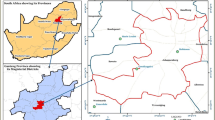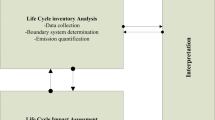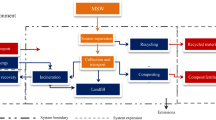Abstract
The sustainable design of the waste-management system is of crucial importance for cities like Tehran, capital of Iran. Tehran’s municipal solid-waste management has adopted modern practices and technologies very slowly. This study proposes the optimum pathway to reach maximum environmental benefits as well as the most cost-effective technologies according to the financial limits. The hybrid life cycle assessment (LCA)–emergy approach is applied to utilize the life cycle emissions as an inventory database to estimate the ecosystem services provided by the natural ecosystem to dilute the emissions and compensate raw material consumption. Among organic waste-treatment options, composting is optimally chosen by the hybrid LCA–emergy approach while considering the LCA method solely; the anaerobic digestion is the preferable option. Recycling is the most preferable solution for paper, plastic, and glass in terms of energy recovery and cost saving. However, the budget constraint affects the results. Considering the budget constraint, 65% of ferrous metals are diverted from recycling into metal landfill. Cost reduction of recycling technologies may divert metal flow from landfill to recycling. The limited budget has a significant impact on recycling solutions. Overall, the combination of composting and source separation should be considered as the most sustainable and eco-friendly pathway in Tehran.






Similar content being viewed by others
Change history
29 October 2019
In the original publication of the article.
Abbreviations
- AP:
-
Acidification potential
- POF:
-
Photochemical ozone formation
- NE:
-
Nutrient enrichment
- FAETP:
-
Freshwater aquatic ecotoxicity potential
- MAETP:
-
Marine aquatic ecotoxicity potential
- TETP:
-
Terrestrial ecotoxicity potential
- RE:
-
Respiratory effect
- IR:
-
Ionized radiation
- ARD:
-
Abiotic resource depletion
- RD:
-
Resource depletion
- GWP:
-
Global warming potential
- EQ:
-
Ecosystem quality
- HTP:
-
Human toxicity potential
- CED:
-
Cumulative energy demand
- IS:
-
Impact score
- CF:
-
Characterization factor
- m :
-
Life cycle intervention
- EI:
-
Environmental impact (end-point impact unit/year)
- NEm:
-
Net emergy
- C:
-
Unit emergy coefficient (SeJ/ton)
- f:
-
Flow of waste (ton/year)
- Mair :
-
Fresh air (kg air/year)
- D:
-
Air density (kg/m3)
- AE:
-
Annual air emission of each technology (kg emission/yr)
- c :
-
Standard concentration for a pollutant (kg emission/m3 air)
- R air :
-
Ecosystem emergy equivalent (SeJ)
- N kinetic :
-
Air kinetic energy (J)
- tr:
-
Transformity (SeJ/J)
- trair :
-
Dry air transformity (SeJ/J)
- v air :
-
Wind speed (m/s)
- TW:
-
Total generation of waste
- W:
-
Waste
- SSW:
-
Source segregated waste
- DDW:
-
Direct disposed waste
- WIP:
-
Waste entered into processing unit
- DW:
-
Total disposed waste
- RW:
-
Total recovered waste
- B:
-
Total annual budget of waste-management system
- O:
-
Operational cost of waste-treatment technology
- e :
-
Impact category
- t :
-
Technology
- x :
-
Substance
- p :
-
Pollutant
- i :
-
Emission compartment
- j :
-
Emergy output item
- k :
-
Emergy input item
- Tr:
-
Treatment node
- \( \tau \) :
-
Waste type (organic, paper, plastic, glass, metal, and other)
- s :
-
Waste source (city, hospital, towns, and firms)
- il:
-
Inert landfill
- pal:
-
Paper landfill
- gl:
-
Glass landfill
- pll:
-
Plastic landfill
- ml:
-
Metal landfill
- ol:
-
Organic landfill
- co:
-
Composting
- ad:
-
Anaerobic digestion
- pa:
-
Paper
- g:
-
Glass
- pl:
-
Plastic
- m:
-
Metal
- or:
-
Organic
- o:
-
Other waste
References
Rigamonti L, Sterpi I, Grosso M (2016) Integrated municipal waste management systems: an indicator to assess their environmental and economic sustainability. Ecol Indic 60:1–7
Shekdar AV (2008) Sustainable solid waste management: an integrated approach for Asian countries. Waste Manag 29:1438–1448
ISO, “ISO 14040:2006,” 2006. [Online]. https://www.iso.org/standard/37456.html. Accessed 2017
Hadzic A, Voca N, Golubic S (2017) Life-cycle assessment of solid waste management in city of Zagreb, Crotia. J Mater Cycles Waste Manag 20:1286–1298
Liu G, Hao Y, Dong L, Yang Z, Zhang Y, Ulgiati S (2017) An emergy-LCA analysis of municipal solid waste management. Resour Conserv Recycl 120:131–143
Cherubini F, Bargigli S, Ulgiati S (2009) Life cycle assessment (LCA) of waste management strategies: landfilling, sorting plant and incineration. Energy 34:2116–2123
Laurent A, Bakas I, Clavreul J, Bernstad A, Niero M, Gentil E, Hauschild MZ, Christensen TH (2014) Review of LCA studies of solid waste management systems—part I: lessons learned and perspectives. Waste Manag 34(3):573–588
Ikhlayel M (2018) Development of management systems for sustainable municipal solid waste in developing countries: a systematic life cycle thinking approach. J Cleaner Prod 180:571–586
Chaya W, Cheewala SH (2007) Life cycle assessment of MSW-to-energy schemes in Thailand. J Cleaner Prod 15:1463–1468
Banar M, Zerrin C, Ozkan A (2008) Life cycle assessment of solid waste management options for Eskisehir, Turkey. Waste Manag 29:54–62
Khoo HH (2009) Life cycle impact assessment of various waste conversion technologies. Waste Manag 29:1892–1900
Assamoi B, Lawryshyn Y (2011) The environmental comparison of landfilling vs. incineration of MSW accounting for waste diversion. Waste Manag 32:1019–1030
Evangelisti S, Lettieri P, Borello D, Clift R (2013) Life cycle assessment of energy from waste via anaerobic digestion: a UK case study. Waste Manag 34:226–237
Di Maria F, Micale C, Contini S, Morettini E (2016) Impact of biological treatments of bio-waste for nutrient, energy and bio-methane recovery in a life cycle perspective. Waste Manag 52:86–95
Jeswani H, Azapagic A (2016) Assessing the Environmental Sustainability of Energy Recovery from Municipal Solid Waste in the UK. Waste Manag 50:346–363
R. Cremiato, M. L. Mastellone, C. Tagliaferri, L. Zaccariello and P. Lettieri, “Environmental Impact of Municipal Solid Waste Management using Life Cycle Assessment: The Effect of Anaerobic digestion, Materials Recovery and Secondary Fuels Production,” Renewable Energy, 2017
Fernández-González J, Grindlay A, Serrano-Bernardo F, Rodríguez-Rojas A, Zamorano M (2017) Economic and environmental review of waste-to-energy systems for municipal solid waste management in medium and small municipalities. Waste Manag 67:360–374
Dong J, Tang Y, Nzihou A, Chi Y, Weiss-Hortala E, Ni H (2018) Life cycle assessment of pyrolysis, gasification and incineration waste-to-energy technologies: theoretical analysis and case study of commercial plants. Sci Total Environ 626:744–753
Rajcoomar A, Ramjeawon T (2017) Life cycle assessment of municipal solid waste managemet scenarios on the small island fo mauritius. Waste Manage Res 35(3):313–324
Neri E, Passarini F, Cespi D, Zoffoli F, Vassura I (2017) Sustainability of a bio-waste treatment plant: impact evolution resulting from technological improvements. J Cleaner Prod 171:1006–1019
Thomsen M, Seghetta M, Mikkelsen MH, Gyldenkaerne S, Becker T, Caro D, Frederiksen P (2017) Comparative life cycle assessment of biowaste to resource management systems–a Danish case study. J Cleaner Prod 142:4050–4058
Rajaeifar MA, Tabatabaei M, Ghanavati H, Khoshnevisan B, Rafiee S (2015) Comparative life cycle assessment of different municipal solid waste management scenarios in Iran. Renew Sustain Energy Rev 51:886–898
Nabavi-Pelesaraei A, Bayat R, Hosseinzadeh-Bandbafha H, Afrasyabi H, Chau K-W (2017) Modeling of energy consumption and environmental life cycle assessment for incineration and landfill systems of municipal solid waste management—a case study in tehran metropolis of Iran. J Cleaner Prod 148:427–440
Brown M, Sweeney S, Campbell DE, Rydbergy T, Wigand C, Schuetz NB (2015) Emergy synthesis 8: theory and applications of the emergy methodology. In: 8th Biennial Emergy Conference
Brown MT, Brandt-Williams S, Tilley D, Ulgiati S (1999) Emergy Synthesis: An Introduction,” Gainesville, Florida
Amponsah Y, Corre OL (2011) Critical review of the usage of unit emergy values in recent studies. Gainesville, Florida
Raugei M, Rugani B, Benetto E, Ingweresen WW (2013) The added value of integrating emergy into LCA. Gainesville, Florida
Lei K, Wang Z (2008) Municipal wastes and their solar transformities: an Emergy synthesis for Macao. Waste Manag 28:2522–2531
Almeida C, Frimaio G, Bonilla S, Da Silva C, Giannetti B (2012) An evaluation of a MSW-to-energy system using emergy synthesis. Int J Environ Sustain Dev 11(3):258–273
Marchettini N, Ridolfi R, Rustici M (2006) Environmental analysis for comparing waste management options and strategies. Waste Manag 27:562–571
Granai C, Pulselli RM, Ridolfi R (2006) Environmental accounting of a waste management system: outcomes from the emergy analysis. WIT Trans Ecol Envrion 94:31–38
Liu G, Yang Z, Chen B, Zhang Y, Su M, Zhang L (2013) Emergy evaluation of the urban solid waste handling in Liaoning Province, China. Energies 6:5486–5506
Bala Gala A, Raugei M, Ripa M, Ulgiati S (2015) Dealing with waste products and flows in life cycle assessment and emergy accounting: methodological overview and synergies. Ecol Model 315:69–76
Rugani B, Benetto E (2012) Improvements to emergy evaluations by using life cycle assessment. Environ Sci Technol 46:4701–4712
Raugei M, Rugani B, Benetto E, Ingweresen WW (2014) Integrating emergy into LCA: potential added value and lingering obstacles. Ecol Model 271:4–9
Odum HT (2000) Handbook of emergy evaluation: a compendium of data for emergy computation issued in a series of folios (Folio #2 Emergy of Global Processes). Center for Environmental Policy, Gainesville
University of Waterloo (2004) Integrated Waste Management Model for Municipalities. Waterloo, ON
Goedkoop M, Spriensma R (2001) The eco-indicator 99: a damage oriented method for life cycle impact assessment. Amersfoort
Yang Z (2017) Eco-cities: a planning guide, 1st edn. CRC Press, Boca Raton
Akhavan Limoodehi F, Tayefeh SM, Heydari R, Abdoli MA (2017) Life cycle assessment of municipal solid waste management in Tehran. Environ Energy Econ Res 1(2):207–218
Heidari L, Jalili Ghazizade M (2017) Municipal solid waste management using life cycle assessment approach: case study of Maku city. Iran. Int J Mech Mech Eng 11(6):1256–1261
Moradikia S (2015) Emission estimation of Tehran’s organic waste collection and transportation activities and result evaluation of some conservative transportation scenarios. Tehran Waste Manag Org, Tehran
Moradikia S (2015) Final report of waste management’s cost calculation in city of Tehran (in Persian), Tehran
Tahmasebi V (2012) Offering solutions for recycling management in city of Tehran (in Persian), Tehran
Nasiri J (2008) Feasibility study of biogas plant in saveh (in Persian). In: 4th National Conference of Waste Management, Tehran
Rand T, Haukohl J, Marsen U (2000) Municipal Solid Waste Incineration: A Decision Maker’s Guide. Washington D.C, World Bank
Group of Authors (2011) Technical and Economic Analysis of Cardboard Egg-holder from Recycled Paper (in Persian). Iran San’at, Shirvan, Northern Khorasan
Group of Authors, “Primary Feasibility Study on Recycling of Plastic Scrap (in Persian),” Northern Khorasan Province, 2011
Vaziri M (2007) Primary feasibility study on zinc and aluminium recycling from juice container (in Persian),” Khorasan Razavi Province
Author information
Authors and Affiliations
Corresponding author
Additional information
Publisher's Note
Springer Nature remains neutral with regard to jurisdictional claims in published maps and institutional affiliations.
Appendix
Appendix
See Tables 7, 8, 9, 10, 11, 12.
Rights and permissions
About this article
Cite this article
Falahi, M., Avami, A. Optimization of the municipal solid waste management system using a hybrid life cycle assessment–emergy approach in Tehran. J Mater Cycles Waste Manag 22, 133–149 (2020). https://doi.org/10.1007/s10163-019-00919-0
Received:
Accepted:
Published:
Issue Date:
DOI: https://doi.org/10.1007/s10163-019-00919-0




